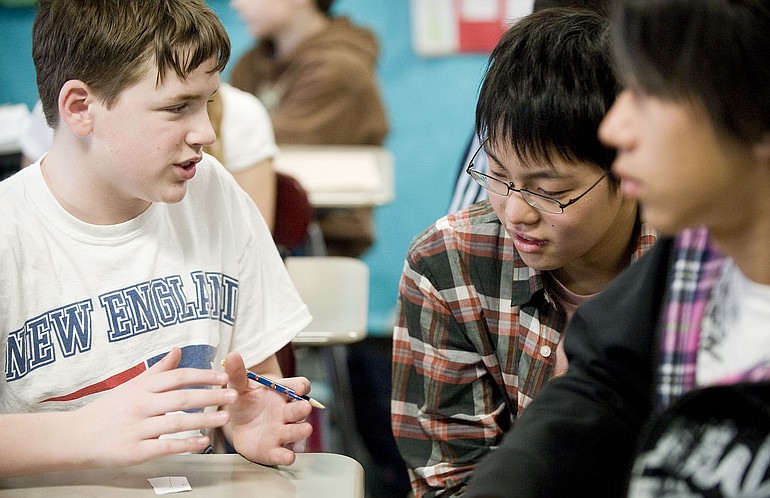CAMAS — As the smiling face across from her stared at her lunch plate, Ella Dewars mimed a hand motion informing her it was appropriate to eat her tater tots with her hands.
Mari Kakei, a 13-year-old from Hosoe, Japan, popped the potato nugget into her mouth. Whether she understood Dewars’ words or actions, she got the message.
“You have to be clear with them,” Dewars, an eighth-grader at Skyridge Middle School, said of her school’s Japanese visitors. “You can’t use the same slang. It’s good for us to use (correct) English.”
Skyridge Middle School welcomed 20 junior high students from Hosoe, Japan, on Thursday, in conjunction with Camas’ sister-city relationship with Hosoe. The relationship, and the regular visits, stretch back some 30 years. Hosoe, a city of around 22,000 people, is more than 130 miles south of Tokyo.
The students’ visit came two weeks after a catastrophic earthquake and tsunami killed thousands along the northeast coast of Japan. The quake did not directly impact Hosoe.
While some entertainment events have been canceled around Hosoe due to the natural disaster, there was no talk of the school trip being canceled due to its educational nature, trip organizer Yoshihiko Tsuge said.
“This kind of experience is a very precious experience for them,” he said. “They will remember this experience forever.”
The Japanese students arrived in Camas Tuesday and are in town until Sunday. They visited Liberty Middle School Wednesday and Skyridge Middle School the next day. They will tour Fort Vancouver and Pendleton Woolen Mills today and spend Saturday with their host family before flying home Sunday.
The students’ brief interactions would prove invaluable to their future development, educators from both countries agreed.
“It not only broadens students’ horizons to think about what’s happening beyond Camas and the country, but it also puts a face on another way of life and connects them on a personal level,” Skyridge Middle Principal Aaron Smith said.
Students from Skyridge visited Japan last summer, he noted.
On the wall across from Skyridge’s library entrance a display called the Wall of Hope greeted visitors.
The exhibit featured tracings of hundreds of students’ hands with inspirational messages to the Japanese people inside. Among them were two combined blue hands — one with an American flag, the other with a Japanese flag — with the words “sharing is caring” written on the palms.
The word “hope” was written in Japanese characters on the display’s center.
“It was really unique,” said Machiko Domori, one of the students’ escorts.
While Skyridge always tries to do something special to greet its Japanese visitors, librarian Connie Pappas said the school felt it was important to do something more in the wake of the earthquake and tsunami.
“You can always give hope,” said Pappas, the display’s organizer. “Not everybody can afford to give money.”
Japanese educators and their American counterparts remarked on how different some of the countries’ school practices were. For instance, American schools have more teacher-student dialogue, trip chaperones said.
Applications submitted for the visit to Camas were down after the local government ended subsidies for the $1,400 trip, Tsuge said. Seventeen of the 20 Japanese students who attended the trip were female. Female students are more active in Japan, educators said.
The Japanese students were shy and spoke little English. As a result, Skyridge students used hand signals and limited English to communicate with their Japanese peers. Meanwhile, the Skyridge students learned a few words in Japanese, including sun, moon and Earth.
The language barriers did not exist for Skyridge eighth-grader Tamaki Murata. Murata’s parents are from Japan. Around 11 percent of Skyridge’s more than 700 students are Asian-Americans, officials said.
“I don’t really get to talk to anyone, except my parents, in Japanese,” she said.
Murata, who has visited her parents’ native country several times, added it was fun to learn about the differences and similarities between students in the two countries. Among the Japanese student rituals that surprised her were their mandatory school uniforms and their daily practice of sweeping their classrooms.
The bonds that are made between the two groups of students will hopefully be long-lasting, educators said.
Nao Nishikawa, a trip chaperone, said she was touched to receive an email from one of Skyridge’s students, who she hosted last summer, checking on her safety following the deadly earthquake and tsunami.
“We hope these are not one-time visits but ongoing” relationships, Smith said. “We hope they’re lifelong.”
Ray Legendre: 360-735-4517, or ray.legendre@columbian.com.



